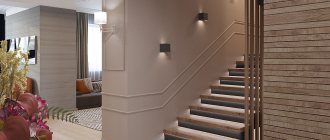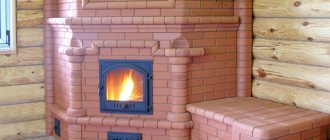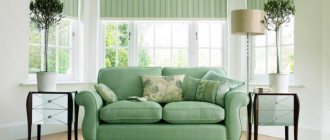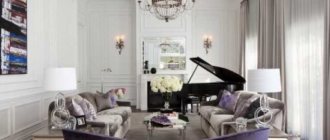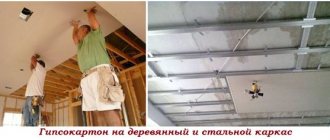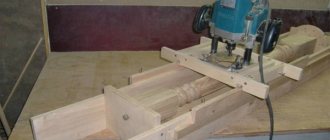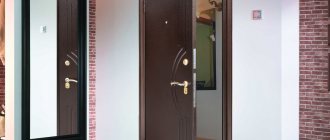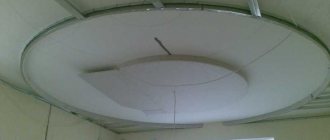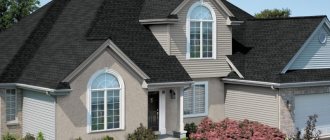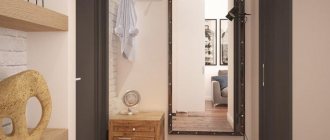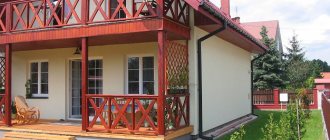The corridor is a connecting element between the entrance and residential areas. In a private house, this room is usually quite spacious and includes a staircase to the second floor. The owners can design the hall independently, or continue the style of other rooms in it. A successful interior solution will be the key to creating a positive impression among guests visiting the house for the first time.
Typically, a hall is a passage room that separates the interior of a house from the outdoor environment.
The hall can serve as a hallway where you can leave outerwear
Or serve as a living room
This article discusses the latest fashion trends, useful recommendations for decorating the interior of halls without the participation of a professional designer.
Features of curtains in the corridor
The main criteria for choosing curtains for the hallway:
- in a large room, curtains made of thick fabrics with rich decor and bright colors look good;
- if the room is small, it is better to opt for curtains made of light, translucent textiles in light colors;
- a corridor with a low ceiling will be visually expanded by curtains with wide vertical stripes;
- large pattern on textiles is suitable for large rooms;
- For light wallpaper it is best to choose curtains 1-2 shades darker, for dark ones - lighter;
- if the walls are decorated with a pattern or design, it is recommended to combine them with plain curtains.
The right choice of curtains will not only decorate the hallway, but also help hide the shortcomings of the room layout.
Popular fabrics
Popular and a level cheaper synthetic fabrics. A prominent representative of such curtains is viscose, the composition of which is combined with linen and cotton. This solution is used to create interesting draperies. Caring for this type is simple and does not take much time.
Mesh with aluminum threads is an excellent alternative to curtains for the hallway. Colored interlining adds originality to the design. With its appearance it resembles fallen frost and creates a special atmosphere.
It is worth noting high-quality, natural linen products. They also contain synthetic materials, which together look soft and airy.
Note! To add a touch of luxury and presentability, select gold threads for the product.
For a bright style flow, crinkled tulle with an interesting image is suitable. Rubber knurling with interesting patterns is used for modern trends and is the latest innovation.
Designers advise using this innovation with curtains of heavy materials. Together, a 3D image is obtained. This choice will instantly attract the attention, approving and admiring glances of guests.
Modern trends often use geometric patterns, wide lines, or small floral patterns.
Important! Remember that velvet and silk materials are vulnerable and susceptible to sunlight. To avoid harmful effects when using natural fabrics, it is necessary to select a high-quality inner side of the product. This feature will not only preserve external characteristics, but will also add additional volume to the product.
Purpose of curtains
Curtains in the hallway perform the following functions:
- Sun protection;
- zoning of space;
- room decoration;
- protecting the room from prying eyes;
- microclimate regulation, protection from heat or cold.
Curtains in the hallway help emphasize the style of not only a separate room, but also the entire apartment or house. Properly chosen curtains help to understand whether the owners prefer romantic Provence, functional minimalism or luxurious baroque.
Curtains hide your home from prying eyes.
What materials are they made from and sizes?
The size of the curtains is chosen depending on the length and shape of the window, as well as the style of the room.
Basic tips:
- for a narrow window, it is best to choose long curtains with garters or tie-backs that will visually expand it;
- a wide window opening will be decorated with multi-layer curtains with a lambrequin;
- for a window of a non-standard shape, shortened curtains with fan-shaped folds or tulle are suitable;
- panoramic windows will successfully complement short curtains similar to lambrequins;
- Long curtains look good on high windows.
Size and type of curtains for the corridor.
Popular materials for curtains in the corridor:
- Natural fabrics: linen, cotton, satin. They are considered environmentally friendly materials, easy to care for, and have a pleasant textured texture. They softly diffuse light, which visually makes the room more spacious. Used in any style, from country to modern.
- Translucent textiles: veil, organza, tulle. It is light and airy and helps create a relaxing, romantic atmosphere in the room. Used alone or in combination with curtains made from heavier fabrics.
- Matting. A natural material characterized by a characteristic checkerboard weave of fibers. It is in demand due to its durability, ease of care, and impressive appearance even on simple curtain models.
- Heavy textured fabrics: satin, velvet, silk. They are distinguished by high density, strength, rich color and beautiful texture. Used in large, spacious hallways. Suitable for curtain models with lush folds, original draperies, rich, heavy decor. The disadvantages of such materials are the high price and heavy weight, due to which the products need a durable cornice for fastening.
- Jacquard. Fabric with a complex weave of threads. It is distinguished by its unusual texture, ease of maintenance, high strength, and a wide variety of colors and patterns.
- Synthetic materials: viscose, acrylic, polyester, nylon. They are characterized by lightness, softness, and low price. Used to create curtains of any style and complexity of cut.
- Blackout. Fabric that does not allow sunlight to pass through. Often used to make blinds. On the inside it can be plain or decorated with patterns and designs.
In addition to standard fabrics, unusual materials are also used to make curtains: weaving rod, bamboo, wood, beads, bugles, threads. Such original curtains help emphasize the individual style of the hallway.
Blackout curtains in the hallway.
conclusions
One of the important criteria for creating a harmonious, balanced interior is the correct choice of curtains. At the same time, not only the beauty of appearance, but also the quality component is of significant importance.
Depending on the number of window openings, ceiling heights, or width of the room, additional elements are used. The use of wide stripes or floral patterns helps to visually change parameters and hide defects.
Pay attention to the color palette. Light, bright shades help create a warm atmosphere and home comfort. Beige and pastel colors are a more universal option that fits any style.
Follow the designers' recommendations, don't be afraid to experiment.
Types of curtains
In the hallway you can use almost any type of curtains: from classic curtains with tulle to strict blinds or original Roman, Japanese or Austrian curtains. The main thing is to successfully fit them into the interior.
Classic
This type of curtain is a simple sliding curtain that is attached to a curtain rod and falls down in loose folds. It can either hang straight or be pulled to the sides with the help of grabs, hooks, and clips, creating a beautiful drapery.
Classic curtains are most often made from thick, opaque fabrics. They are combined with tulle and various types of decor: from lambrequins to ruffles, bows, pendants, etc.
Classic curtains with a beautiful tieback.
Austrian
This type of curtain is a straight fabric with a special cord system designed to control the height. When using it, the bottom of the curtains is gathered into beautiful round folds, the splendor and depth of which depend on the type of fabric.
Austrian curtains are often used in country, Provence, and classic styles. They are made from light fabrics in pastel shades.
The most suitable decorations for such curtains are cords with tassels, ruffles, and pendants. Shiny fabrics and patterns combine effectively with low folds of curtains.
Austrian style curtains for the hallway.
French
A type of curtain made up of several separate sections, each of which falls in lush, round folds. The drapery is maintained along the entire length of the canvas, regardless of whether it is raised or lowered.
The use of French curtains adds luxury and splendor to the interior, so they are most suitable for hallways in Baroque, Empire, and Classic styles.
They are used both independently and as part of compositions with classic drapes and curtains. In this case, French curtains act as tulle and are made of light, translucent fabrics.
Delicate French curtains in the interior of the hallway.
Bishop's sleeve
This type of curtain is distinguished by the presence of 2-3 volumetric vertical puffs located along the entire length. In appearance, they resemble the decoration of Catholic priests, which is where the name comes from. Curtains of this cut hang statically and cannot be moved or moved apart.
The bishop sleeve is used in classical luxury styles such as Baroque and Empire. It is most often used as part of curtain compositions in combination with straight curtains, tulle, lambrequins and other decor.
Curtains in this style hang statically.
Roman
This type of curtain is a flat canvas with several strips of hard material installed inside. As it rises, it forms uniform, wave-shaped folds that overlap each other.
Roman curtains are distinguished by their simplicity of design, so they are suitable for any style, from classic to hi-tech. They are sewn from any transparent and dense fabrics and are often used in creating curtain compositions.
Roman blinds in the hallway.
Italian
This type of curtains resembles classic curtains with a modified method of attachment to the cornice: they do not move apart, but remain fixed. The sides of the curtains are stitched with cords from the back of the fabric.
They regulate the depth and width of folds during drapery. Italian curtains are used in any style, from baroque to country.
Italian classic curtains.
Japanese
This type of curtain is a straight, rigid sheet of fabric stretched over a frame and attached to a sliding mechanism. In appearance it resembles a wardrobe door. It is used not only on windows, but also as internal partitions for zoning a room.
Functionality and brevity make Japanese curtains popular in styles such as hi-tech, minimalism and modern. They are often decorated with black and white or color designs or painted to imitate the color and texture of natural materials: wood, bamboo, etc.
Japanese curtain panels for room zoning.
Cafe curtains
A type of curtain that is a single or double layer curtain that covers only the bottom half of the window. They are used in rooms decorated in country, Provence, and rustic styles.
Cafe curtains visually expand the room, make it light and cozy, so they look appropriate even in small hallways.
Original cafe curtains.
Design features
Often the front room is used not only as an entrance hall, but also as a place to place books, photographs, decor, and a dressing room. In private houses, the hall goes well with terraces and can smoothly transition into a dining area or living room. Before creating a project, it is important to decide on the purpose of the room and its functional elements, and take into account the features of the space.
Characteristic properties of the hall
- Lack of natural light. Even if a hall is planned in a private house, it does not always have full windows. The apartments don’t have them at all, which creates a problem with lighting. To do this, you need to carefully consider the location of lighting fixtures.
- Patency. It is in this room that most people pass through, most often wearing shoes (couriers, acquaintances, guests, etc.). Therefore, the finishing materials used must be resistant, durable, and easy to maintain.
- Correct layout. Even a spacious hall can turn into an impractical area if the furniture is placed incorrectly. First of all, they should not interfere with the passage of people. In addition, you need to leave room for comfortable getting ready before going outside.
- Necessary zoning. Even if the hall is connected to the living room, dining room or other rooms, it is important to correctly zoning the space using color, textures, height differences, finishing materials, furniture, etc. The absence of hallway boundaries will lead to the spread of contaminants from clothes and shoes throughout the house.
Furnishing a small hall is somewhat more difficult due to the number of doors that lead to other rooms, the lack of space for basic furniture, etc. But designers offer compact and interesting solutions that can solve any problem.
Curtains according to the type of fastenings in the hallway
There are different types of curtain mounts: from simple ceiling curtain rods to interesting eyelets, garters, rings and other accessories that give the canvas interesting folds and highlight the features of the window.
On hinges
Curtains are hung on a beam using several loops located along the entire length. They can be made of threads, ropes, fabric. There are options with buttons, bows and original ties: they add romance and playfulness to the interior.
The advantages of this method of fastening: beauty, reliability, no risk of damaging or tearing the canvas when moving. In addition, the loops can be moved independently of each other, adjusting the depth and shape of the folds.
Curtains with hinges.
On the eyelets
Curtains are attached to the curtain rod using several even holes located across the entire width of the curtain. For convenience, they are sheathed with thick fabric, trimmed with metal or wood: this provides more convenient fastening and protects the product from damage.
This method of fastening is not only practical, but also beautiful: it provides uniform wavy drapery along the entire length of the curtains.
Straight, long curtains are most often attached to grommets. They are appropriate in high-tech, modern, and functionalist styles. The characteristic, spectacular folds reminiscent of waves fit well into minimalist interiors.
In designs where simple straight curtains are inappropriate, they are complemented with lambrequins, ties and various decorations.
Curtains with eyelets.
With strings
Curtains are attached to the curtain rod using several cords or ribbons located at the top of the curtain. They are tied in a knot or a bow. This method of fastening ensures easy sliding of the curtains, which allows you to adjust the level of lighting and the density of the folds.
Curtain ties can be tied in a bow.
On the drawstring
This method of attaching curtains requires a specially stitched pipe pocket on the canvas. With its help, the product is hung on a cornice or fishing line.
At the same time, the curtains are gathered into a drapery both at the top and at the bottom, which gives them beauty and elegance.
Most often, curtains with drawstrings are used in spacious rooms with high ceilings, as they visually reduce the space. They are decorated with lambrequins, various garters, bows, and ruffles. The fastening method looks impressive with heavy fabrics that gather in flowing folds.
Drawstring curtains for spacious rooms.
Choosing curtains in the hallway of a private house
Interior design in a private home is most often aimed at creating a calm, cozy environment. This should be taken into account when choosing curtains.
Curtains of a simple cut with soft colors, simple patterns, and light decor in the form of ties, bows, and tassels would be appropriate. It is better to avoid lambrequins and other elements that tend to collect dust and dirt.
The preferred materials are natural fabrics: cotton, linen, organza. On a window facing the sunny side, thick wool curtains would be appropriate.
Textiles that create a play of light look good: taffeta, silk, velvet. If there are bushes and trees outside the window of a private house that provide shade, you should choose curtains made of light, translucent fabrics, such as voile, cambric, or chiffon.
Curtains for a large house.
Peculiarities
In the photo of curtains for a private house, the color scheme is noticeable, which in this case prevails. Natural shades are chosen to a greater extent. This option is perfect for large, spacious windows. The choice is influenced by the location of the house and which side of the world the windows face.
There are a huge number of options for curtain material for a private home, which pleases with its diversity. Silk, cotton, wool, and synthetic fabrics are used in modern design. Organza and linen materials are welcome in this case.
A distinctive feature of fabrics is their textured features. Choose a matte, printed, corrugated or smooth surface.
Taffeta looks special. Using this material it is possible to create original curtains, voluminous, colorful products. The most popular solutions are chameleon organza and silk materials.
The advantage of the first solution is a change in color tone, a kind of visual illusion. For a modern design, organza in a high-tech style is suitable. Its peculiarity lies in the metallized threads, which skillfully shimmer in the light of day.
The category of expensive materials for curtains in a private home includes wool, lavsan with additional accessories in the form of embroidery. Tulle with a double lace cut will look appropriate and complement the overall stylistic picture.
Style solutions
The choice of curtains depends on the overall style of the room.
Tips and selection rules:
- In design directions focused on the luxury and richness of the room (Baroque, Empire), curtains made of heavy textured fabrics with original decor and complex composition are used.
- In modern, high-tech, and minimalism, blinds, Japanese panels or Roman blinds of calm colors with rigid lambrequins and a minimum of decorations are preferred.
- In Provence and country styles, light curtains made of natural materials with drapery and decorations in the form of bows, tiebacks, and ties look appropriate.
- Light translucent tulle or minimalistic Roman blinds suit the Scandinavian interior.
- In shabby chic, curtains made of light opaque fabrics with embroidery, ribbons, and patterns are appropriate.
- In eco-style, simple curtains made of natural fabrics, as well as blinds made of bamboo or wood, are preferred.
- Long curtains made of thick dark fabrics suit the industrial loft.
- Bright, richly decorated curtains made of thick fabrics with lush folds look good in an oriental interior.
Correctly chosen curtains should not only match the overall style of the room, but also be combined with the facades and upholstery of furniture, other textiles, wall and floor decoration. This should be taken into account when purchasing them for the hallway.
Variety of styles and materials.
Which curtains to choose
The choice of curtains depends on the presence and location of the window, the general style of the hallway and its size. When choosing curtains for a small room, you need to take into account some design rules:
- in a narrow room, light transparent tulle is suitable;
- to visually expand the space, you can use curtains with a horizontal pattern;
- in a low room it is better to hang textiles with a vertical pattern, which will visually increase the height;
- It is better to choose curtains without complex patterns.
Another option is curtains for decorating an arched or doorway, which will serve to delimit the space. Most often, this option is used in larger rooms. If the room is in the shade and there is a lack of light, then it is better to use more transparent curtains. When the window faces the sunny side, choose lined curtains so that they do not fade in the sun.
In a large room you can hang canvases made of heavy expensive fabric, decorated with patterns. Synthetic models in this case are a more practical option that does not require special care.
On video: how to choose curtains.
Related article: Window decoration in the hall: recommendations for choosing tulle
How to decorate an arched opening
The arch in the corridor is covered with curtains to zone the room. The classic option is long curtains made of thick fabric. They are hung on the eaves and taken to the walls using hooks, cords or garters so that the canvas does not block the passage.
An alternative solution is to curtain the arch with light flowing tulle. This will give the interior lightness, especially if it is made in light colors.
If an arch is present in a corridor decorated in a modern or minimalist style, straight sliding curtains made of thick fabric would be a good option. They can be used instead of doors to functionally divide a room into zones.
Design of an arched doorway.
Advantages and disadvantages
Advantages of curtains in the hallway:
- the ability to decorate a room with little effort and time;
- variety of colors, shapes, sizes;
- appropriateness in all interior styles;
- the ability to hide shortcomings and draw attention to the advantages of the corridor layout, window shape and other features of the room;
- performing practical functions (protecting the hallway from cold and heat, sunlight, prying eyes from the street);
- a wealth of design and decor options.
Disadvantages of curtains include the need for regular maintenance and the tendency of folds and draperies to accumulate dust and dirt.
Beautiful photos
The main thing when choosing curtains for the corridor is to create a successful interior composition. To do this, you need to take into account factors such as the layout of the room, the shape and size of the window, the decoration of the walls and floors, the arrangement of furniture and accessories. You can get acquainted with successful ideas and design solutions by looking at the photos.
Curtains for arched windows.
Light curtains for the windows.
Curtains for a large window.
Photo of curtains in the hallway
Read here How to decorate curtains - useful tips and options for the best decoration ideas on 115 new photos!
Did you like the article? Share 
